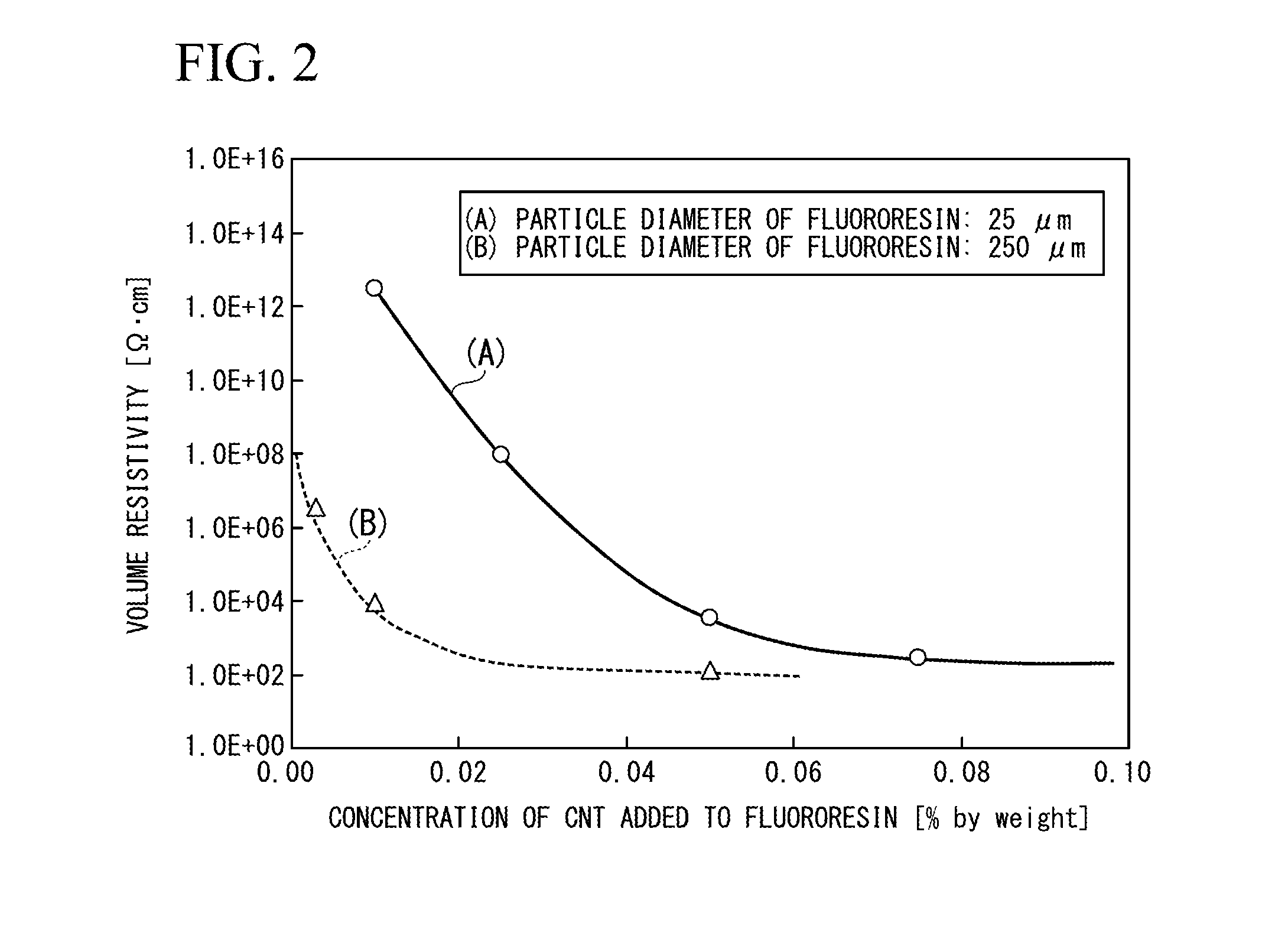Composite resinous particles, method of producing composite resinous particles, composite resin molded body, and method of producing same
a technology of composite resin and resin atoms, which is applied in the direction of non-metal conductors, bulk chemical production, organic conductors, etc., can solve the problems of reducing the number of contacts between the resin and the other, reducing the electrical conductivity performance, and not increasing the strength of the composite resin, etc., to achieve high productivity and simple method , simple method
- Summary
- Abstract
- Description
- Claims
- Application Information
AI Technical Summary
Benefits of technology
Problems solved by technology
Method used
Image
Examples
experiment 1
Production of Composite Resin Material Particles
[0110]The apparatus shown in FIG. 1 were used to produce composite resin material particles by the procedures mentioned below.
[0111]First, a beaker was filled with 20 ml of ion-exchanged water, to which 200 mg of sodium cholate was added as a dispersing agent. Subsequently, the mixture was subjected to ultrasonic dispersion for 10 minutes using an ultrasonic disperser (ULTRA SONIC HOMOGENIZER UH-50, SMT Co., Ltd.; 50 W, 20 kHz), to prepare an aqueous dispersing agent solution.
[0112]Highly oriented carbon nanotubes (with an average diameter of 11 nm and an average length of 145 μm) were produced on a silicon substrate according to the method disclosed in Japanese Patent Application Publication No. 2007-222803, titled “CATALYST FOR GROWING CARBON NANOSTRUCTURE, METHOD FOR PRODUCING CARBON NANOSTRUCTURE, AND GAS AND CARRIER GAS FOR, AND APPARATUS FOR PRODUCING CARBON NANOSTRUCTURE”.
[0113]Then, the carbon nanotubes produced were detached f...
experiment 2
Relationship Between the Concentration of Carbon Nanotubes Added and Volume Resistivity
[0126]According to the procedures shown in the above-mentioned Experiment 1, electrically conductive fluororesin moldings were prepared in which the concentration of carbon nanotubes added was changed to 0.01%, 0.025%, 0.05%, and 0.075% by mass. Volume resistivities of the resulting electrically conductive fluororesin moldings were measured. The results are shown in FIG. 2. As shown by (A) in FIG. 2, these moldings had a volume resistivity of 2.81×1012, 8.98×107, 3.49×103, and 268 Ω·cm, respectively.
experiment 3
Relationship Between the Concentration of Carbon Nanotube Added and Volume Resistivity
[0127]Experiments were carried out in the same way as the above-mentioned experiments where the average particle diameter was 25 μm, except that fluororesin particles with an average particle diameter of 250 μm were used as the fluororesin particles and the concentration of carbon nanotubes added was changed to 0.003%, 0.01%, and 0.05% by mass. The results are shown in FIG. 2. As shown by (B) in FIG. 2, these moldings had a volume resistivity of 3.45×106, 8.90×103, and 129 Ω·cm, respectively.
PUM
| Property | Measurement | Unit |
|---|---|---|
| length | aaaaa | aaaaa |
| length | aaaaa | aaaaa |
| volume resistivity | aaaaa | aaaaa |
Abstract
Description
Claims
Application Information
 Login to View More
Login to View More - R&D
- Intellectual Property
- Life Sciences
- Materials
- Tech Scout
- Unparalleled Data Quality
- Higher Quality Content
- 60% Fewer Hallucinations
Browse by: Latest US Patents, China's latest patents, Technical Efficacy Thesaurus, Application Domain, Technology Topic, Popular Technical Reports.
© 2025 PatSnap. All rights reserved.Legal|Privacy policy|Modern Slavery Act Transparency Statement|Sitemap|About US| Contact US: help@patsnap.com


